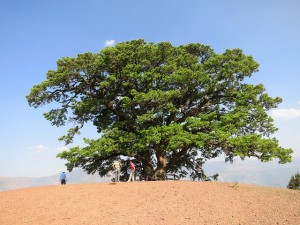
Scientists are still struggling to close knowledge gaps when it comes to the diversity of trees worldwide. Not knowing enough about tree diversity reduces the effectiveness of conservation, management, restoration and use of trees – and consequently of forests.
This is one of the main messages from a recent discussion among researchers involved in the CGIAR Research Program on Forests, Trees and Agroforestry (FTA), Flagship 2 Management and conservation of forest and tree resources.
“From my perspective, I think one of the knowledge gaps is that we’re dealing with so many species that grow in different places,” said Bioversity International’s Laura Snook, coordinator FTA Flagship 2. “Are they under threat? Are they widespread? How do their traits vary among populations?”
Jenny Ordonez from the World Agroforestry Centre (ICRAF) confirmed the same challenge exists for the agroforestry sector.
“Just in Central America, we have over 500 species in different agroforestry systems, of which only 10 or 20 systems are very well known. The rest is really, literally unknown. What are the characteristics of each species? What are the management options?” she asked.
Jonathan Cornelius, also from ICRAF, explained how limited knowledge about tree species makes it difficult to prioritize collection for gene banks. For example, species with both short distance seed distribution and short distance pollination are more likely to be affected adversely by forest fragmentation, because they become genetically isolated. It might make sense for gene banks to prioritize and preserve such species.
ICRAF’s Alice Muchugi is also struggling with prioritizing species. “We have so many species we need to focus on in the tropics,” she said. Muchugi works on ICRAF’s gene bank, where currently fruit trees and fertilizer trees are prioritized.
“But what do we collect if we don’t know the diversity that exists? Will the forests or the trees still be in existence by the time we realize that a certain key diversity was important?” Muchugi questioned. She expressed her concern about “the rate at which we are losing forests” and thinks that governments, especially in Africa, don’t focus enough on conservation.
Knowledge about tree diversity – both species diversity and intra-species diversity – is not only crucial for the conservation of forest and tree resources, but also for reforestation and land restoration efforts. Interactions between genetic material and the environment need to be understood before planting materials are introduced outside their locations of origin, explained Muchugi.
Evert Thomas from Bioversity International agreed that it is crucial to select appropriate planting material in order to sustainably restore forests. “If seed sources are not matched to the site or they’re not genetically diverse enough to survive and regenerate on site, particularly in light of climate change, then the restoration investment will not succeed. And this is what has happened in many cases in the past – failure,” he emphasized.
More positively, Laura Snook added that Bioversity’s synthesis of knowledge and experience about ecosystem restoration using native tree species has been shared with the Convention on Biological Diversity who then put out a call to pay attention to both native species and genetic diversity in conservation and restoration activities. “We hope that will lead to a wide recognition of the importance of these aspects to restoration,” she said.
Other challenges facing the researchers include
- Limited access to diverse germplasm: There are very few programs for selection of tree materials and making them accessible for farmers.
- Incentives for keeping trees on farms: Most regulations currently deal with forest conservation, which does not work to foster tree management on farms.
- Effects of climate change on trees: Climate change is expected to affect trees, e.g. by limiting their distribution range or selecting a subset of survivors within the overall population.
- Not enough evidence for effectiveness of forest certification: 20 years after the introduction of certification schemes, there is insufficient empirical evidence showing the real impacts; research to evaluate this is under way within FTA
- Lack of good indicators and of baselines to monitor success of forestrestoration: So far, success has been measured numbers of trees planted, but good indicators should be about the likelihood of long-term survival of restored tree populations.
Read the full discussion or learn more about FTA Flagship 2.











